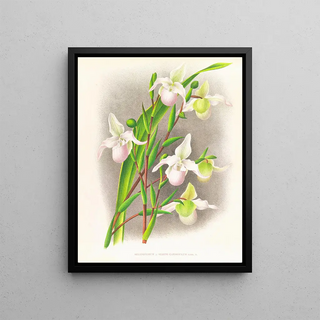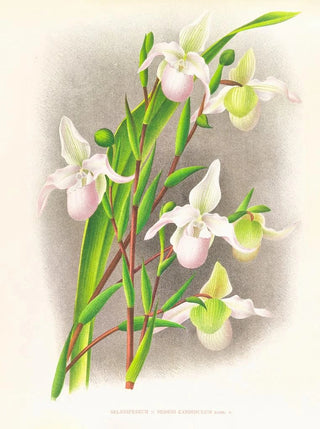Art print | Selenipedium sedeni candidulum - Jean Jules Linden Source: Reproduction | Selenipedium sedeni candidulum - Jean Jules Linden


View from behind

Frame (optional)
In the fascinating world of floral art, the art print "Selenipedium sedeni candidulum" by Jean Jules Linden stands out for its elegance and delicacy. Capturing the very essence of nature, this piece demonstrates a deep respect for the beauty of the plant world. Through this art print, the artist transports us to a lush garden where each petal seems to tell a story—a dance of colors and shapes that awakens the senses. Linden's work is much more than a simple representation; it is an invitation to contemplate the splendor of flora, a tribute to the diversity and richness of nature.
Style and uniqueness of the art print
Jean Jules Linden's style is characterized by meticulous precision and rare sensitivity. In "Selenipedium sedeni candidulum," he manages to fuse realism and poetry, offering an almost dreamlike vision of this orchid. The details are rendered with such finesse that every vein of the petals, every shade of color, seems to vibrate under the light. The artist uses a delicate palette, blending soft and luminous tones that evoke the freshness of a sunny morning. This piece does not merely depict a flower; it creates an atmosphere, a palpable emotion that transports the viewer into a space of serenity and wonder. The composition, balanced and harmonious, demonstrates exceptional craftsmanship, where each element finds its place within a coherent and soothing whole.
The artist and his influence
Jean Jules Linden, botanist and artist, dedicated his life to the study and representation of plants. His work is the result of a deep passion for nature, but also a desire to share this beauty with the world. Influenced by the artistic currents of his time, Linden was able to incorporate innovative techniques into his works, while respecting the traditions of floral painting. His influence extends far beyond his era, inspiring many artists and botanists to explore the relationship between art and nature. Through his works, he helped raise public awareness of biodiversity's richness, making each painting a silent plea for the preservation of plant species. The depth of his commitment

Matte finish

View from behind

Frame (optional)
In the fascinating world of floral art, the art print "Selenipedium sedeni candidulum" by Jean Jules Linden stands out for its elegance and delicacy. Capturing the very essence of nature, this piece demonstrates a deep respect for the beauty of the plant world. Through this art print, the artist transports us to a lush garden where each petal seems to tell a story—a dance of colors and shapes that awakens the senses. Linden's work is much more than a simple representation; it is an invitation to contemplate the splendor of flora, a tribute to the diversity and richness of nature.
Style and uniqueness of the art print
Jean Jules Linden's style is characterized by meticulous precision and rare sensitivity. In "Selenipedium sedeni candidulum," he manages to fuse realism and poetry, offering an almost dreamlike vision of this orchid. The details are rendered with such finesse that every vein of the petals, every shade of color, seems to vibrate under the light. The artist uses a delicate palette, blending soft and luminous tones that evoke the freshness of a sunny morning. This piece does not merely depict a flower; it creates an atmosphere, a palpable emotion that transports the viewer into a space of serenity and wonder. The composition, balanced and harmonious, demonstrates exceptional craftsmanship, where each element finds its place within a coherent and soothing whole.
The artist and his influence
Jean Jules Linden, botanist and artist, dedicated his life to the study and representation of plants. His work is the result of a deep passion for nature, but also a desire to share this beauty with the world. Influenced by the artistic currents of his time, Linden was able to incorporate innovative techniques into his works, while respecting the traditions of floral painting. His influence extends far beyond his era, inspiring many artists and botanists to explore the relationship between art and nature. Through his works, he helped raise public awareness of biodiversity's richness, making each painting a silent plea for the preservation of plant species. The depth of his commitment






